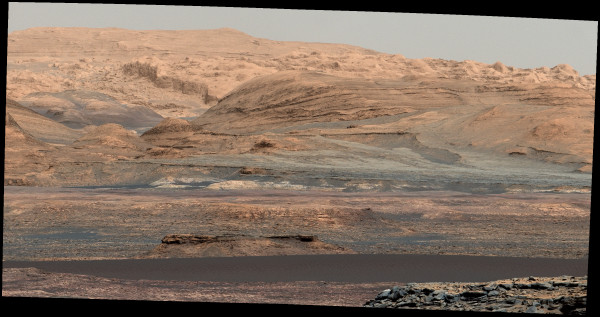"Actually I think Art lies in both directions - the broad strokes, big picture but on the other hand the minute examination of the apparently mundane. Seeing the whole world in a grain of sand, that kind of thing." -Peter Hammill
When fine-and-coarse-grained sand is carried by the winds across uneven terrain, sand dunes form here on Earth. But on Mars, where the atmosphere is only 0.7% what it is here, the sand is made of different composition and the winds gust to up to 60 mph (100 kph), do sand dunes behave the same way?
 A close-up of the dunes from the Curiosity rover. Image credit: NASA / JPL-Caltech / MSL Curiosity Rover.
A close-up of the dunes from the Curiosity rover. Image credit: NASA / JPL-Caltech / MSL Curiosity Rover.
The Mars Curiosity rover intends to find out! By observing grain flow, ripples, grain fall and more, and by going into the dunes themselves and scooping them into its analysis devices, we hope to uncover our first understanding of active sand dunes on another planet.
 A full-color view of the rocky terrain of Mount Sharp, with the darker, lower dunes in the foreground. Image credit: NASA / JPL-Caltech / MSL Curiosity Rover.
A full-color view of the rocky terrain of Mount Sharp, with the darker, lower dunes in the foreground. Image credit: NASA / JPL-Caltech / MSL Curiosity Rover.
Come see what we've found so far, and what's next on Curiosity's horizon!

Have a question about the second photo (the close-up of dunes)... The overall color of dunes seems very... well.. alien :)
We generally associate mars with red, yet this close up shows very blue-ish hues. One can see the hints of red and yellow beneath, but almost looks like top soil is blue-grey. Is this because of lighting in this particular case..or is it due to chemical composition.. or is it ice in form of sand.. ?
SL, what about that body of water in the foreground of the 3rd image?
Hey, Tex,
quote from the 3rd photo:-
'with the darker, lower dunes in the foreground.'
:)
Not buying it Ocker Mate. That's gota be water.
look at this:
http://goo.gl/HVAIC2
This could be a HUGE find right before our eyes.
Except your referenced photo is planet earth, not Mars.
:)
Emphasizing the lack of reflections in the Mars photo.
@ALL: If you follow the URLs to the original sources, you will discover that essentially every one of these pictures is shown in false color. The different colors are "enhanced" to identify particular minerals or other geologicl materials.
The "blue" stuff is some particular mineral (which may be different in different groups of images), not water or anything like it. The crackpots who claim otherwise on the Web really have no clue.
You can find many examples of "true color" images from all of the Martian landers; those images are essentially all shades of pale reddish-grey, because of the combination of surface dust and atmospheric haze.
There's some reality behind false images, though. Your eyes and brain work together to make things easier to see. At the very basic sense, you do automatic white balance in bright images, and blue out in dark images (rhodopsin or however it's spelt).
These false image colours are done for the same reason but don't have to conform to what your genetic history has let you to process for.